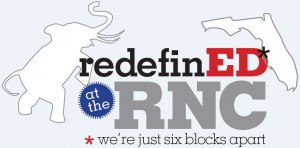While Congress recently rejected plans to support school vouchers or allow federal Title I funding to follow students to any school they choose, there may still be a consolation prize in store for low-income private school students as lawmakers prepare to reconcile competing plans to overhaul a key K-12 education law.
Both the House bill passed earlier this month and the Senate version approved last week include provisions aimed at giving private schools more of a say in how school districts use federal funds for low-income students.
Since it was enacted in 1965, each iteration of the Elementary and Secondary Education Act has set out to provide extra support to disadvantaged students, whether they attend public or private schools.
No Child Left Behind, the version currently on the books, requires school districts to make sure low-income private school students receive tutoring or other services that are "equitable in comparison" to what public-school students receive under Title I.
Some private school representatives say that hasn't always worked in practice, and they sometimes have to jump through hoops to get support for their students who are eligible. The new federal legislation might help.
The U.S. Senate on Tuesday voted down a plan that would have allowed federal education funding for high-poverty schools to follow low-income students wherever they enroll, including private schools.
Sen. Tim Scott, R-S.C., led the push for so-called "Title I portability," which he said would have helped states support school choice for low-income students.
An amendment he offered to a rewrite of the Elementary and Secondary Education Act would have given states the option of allocating their share of federal Title I funding to schools based on the number of low-income students who enrolled.
Advocates at different points of the political spectrum have critiqued the current formulas for distributing $14 billion in Title I funding, which is intended to help high-poverty schools increase services for disadvantaged students.
School choice supporters have long gravitated to proposals like Scott's, which they hope would give schools an incentive to serve low-income students, and a fair share of resources to support them.
"Education policy is not about protecting a bureaucracy," he said this morning on the Senate floor. "It should not be about empowering Washington, and it cannot be about an endless, fruitless push for some one-size-fits-all type of system."
The proposal was defeated 45-51, with seven Republicans joining a united bloc of Democrats in opposition. (more…)
The wonky world of Washington is buzzing as Congress moves closer to passing an updated version of the Elementary and Secondary Education Act.
Developments in D.C. can seem mind-fogging and distant. But this week, we saw why federal policy matters for the school choice movement.
Meanwhile... (more…)
by Robert Enlow
States’ relationship with the federal government in education is like Gollum’s connection with the One Ring in “The Lord of the Rings”: They loves it, and they hates it. States either can “abide with the great pain” and continue with stagnating outcomes, or they can free themselves, their educators, and their families and achieve better academic results.
In 1966, through the adoption of the Elementary and Secondary Education Act, the federal government provided $2 billion for public education (using 2006 dollars). In 2005, that number increased to $25 billion. In 2010, total federal spending on K-12 education reached $47 billion. And in the American Recovery and Reinvestment Act alone, the feds dedicated $100 billion to public education.
This “free” money is what the states love. Who doesn’t love free stuff? But, as Milton Friedman so wisely said, there’s no such thing as a free lunch. With those federal funds come regulations on educators, debt for future generations and significant questions of whether those federal funds are spent on effective programs.
First, the regulations, which states and localities really hate: In 2007, Dan Lips and Evan Feinberg reported that although the federal government provided just 7 percent of overall funding for public education, it was responsible for 41 percent of the administrative burden placed on states. Those regulations inhibit educators, especially rural ones in small schools, from doing their jobs effectively. And they inhibit the ability of state education departments to be as effective and efficient as possible. According to the Heritage Foundation:
“After the passage of No Child Left Behind (an update to the Elementary and Secondary Education Act), several states released calculations comparing the administrative cost of compliance to the amount of federal money they receive under the law. In 2005, the Connecticut State Department of Education found, for example, that Connecticut received $70.6 million through Title I of NCLB but had to spend $112.2 million in implementation and administrative costs.”
The federal government’s involvement in education also is placing a burden on the unborn. The United States is broke! It is nearly $16 trillion in debt. Federal education funds expended to states are borrowed. That, along with the federal government’s other “investments,” is unsustainable and must be curbed. (more…)